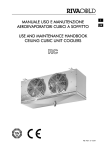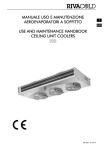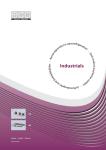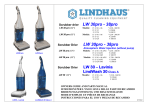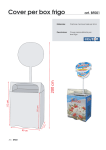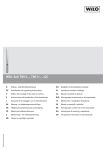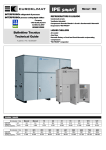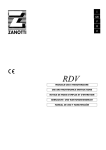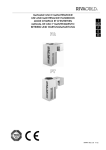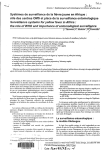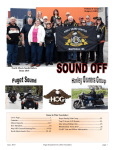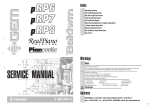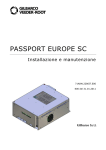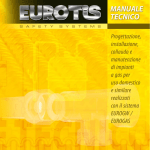Download manuale uso e manutenzione aeroevaporatori a
Transcript
MANUALE USO E MANUTENZIONE AEROEVAPORATORI A SOFFITTO USE AND MAINTENANCE HANDBOOK CEILING UNIT COOLERS RDF RDF REV. 01 04/06 I UK RDF Pag. 2 REV. 01 04/06 ITALIANO SOMMARIO 1. Scopo del manuale 2. Norme di uso generale 3. Modo di identificazione della macchina 4. Installazione 5. Collegamento frigorifero 6. Collegamento scarico condensa 7. Installazione elettrica 8. Dati tecnici 9. Manutenzione e pulizia 10.Smaltimento 11.Guasti e rimedi 12.Optional pag. 3 pag. 3 pag. 4 pag. 5 pag. 6 pag. 6 pag. 7 pag. 10 pag. 10 pag. 11 pag. 12 pag. 12 I 1. SCOPO DEL MANUALE Il presente manuale ha lo scopo di aiutare l’operatore nella corretta messa in funzione dell’evaporatore, chiarire le relative norme di sicurezza vigenti nella comunità europea ed eliminare eventuali rischi da errati utilizzi. 2. NORME DI USO GENERALE • Per un utilizzo corretto e sicuro della macchina, è necessario attenersi alle prescrizioni contenute nel presente manuale in quanto fornisce istruzioni e indicazioni circa: 9 modalità di installazione 9 uso della macchina 9 manutenzione della macchina 9 smaltimento e messa fuori servizio • Il costruttore non risponde per danni derivanti dalla inosservanza delle note e avvertenze contenute nel presente libretto di istruzioni. • Leggere attentamente le etichette sulla macchina, non coprirle per nessuna ragione e sostituirle immediatamente in caso venissero danneggiate. • Conservare con cura il presente manuale. • Il costruttore si riserva di aggiornare il presente libretto senza nessun preavviso. • Gli aeroevaporatori sono realizzati per la sola refrigerazione industriale e commerciale in sede stabile. Non sono consentiti usi diversi da quello destinato. Ogni altro uso è considerato improprio e quindi pericoloso. • Dopo aver tolto l’imballo assicurarsi che la macchina sia intatta in ogni sua parte, in caso contrario rivolgersi al rivenditore. • E’ vietato l’utilizzo della macchina in ambienti con presenza di gas infiammabile e in ambienti con rischio di esplosione. • Non lavare la macchina con getti d’acqua diretti o in pressione, o con sostanze nocive. • Non usare la macchina priva di protezioni (carenatura e griglia) • Evitare che la macchina sia esposta a fonti di calore. • In caso di incendio usare un estintore a polvere. • Il materiale dell’imballaggio deve essere smaltito nei termini di legge. RDF Pag. 3 REV. 01 04/06 MODO DI IDENTIFICAZIONE DELLA MACCHINA Tutte le macchine sono provviste di relativa etichetta di riconoscimento (la posizione è indicata in Fig.1) in cui sono riportati i seguenti dati: assorbimento in Watt (W) • codice tensione di alimentazione (Volt/Ph/Hz) • n° motoventilatori - n° giri (RPM) • gruppo fluido refrigerante: Gruppo 2 (*) assorbimento in Watt (W) • pressione PS (pressione massima di lavoro) assorbimento in ampere (A) tensione di alimentazione (Volt/Ph/Hz) • temperatura TS (temperatura minima di esercizio) • sbrinamento: • matricola n° resistenze 3. I (*) Secondo la normativa EN 378/1 appartengono al Gruppo 2 i seguenti gas : R22,R134a,R507,R404A,R407C,R410A,R410B Tutti gli evaporatori RDF rientrano nella categoria 0 secondo la direttiva 97/23/CE (P.E.D.) Fig. 1 B P B C H P+300 F 50 min 700 min 700 E 140 Etichetta di riconoscimento A Dettaglio A 9 D 30 RDF versione a 3 motoventilatori con 3 staffe di fissaggio RDF Pag. 4 REV. 01 04/06 Tabella caratteristiche modelli RDF –250 Modello RDF Dimensioni (mm) 1250 2250 3250 4250 1250ED 2250ED 3250ED 4250ED P 335 735 1135 1535 B 93,5 93,5 93,5 93.5 C 710 710 710 710 D 650 650 650 650 E 638 638 638 638 H 150 150 155 160 F 50 50 50 50 10 x 1mm – 1/2” SAE 10 x 1mm - 1/2” SAE 12 x 1mm - 1/2” SAE 12 x 1mm - 1/2” SAE Ø entrata Attacchi I Ø uscita 12 x 1 mm 12 x 1 mm 18 x 1mm 22 x 1mm Ø scarico 1/2" gas (20mm) 1/2" gas (20mm) 1 gas (33mm) 1 gas (33mm) Peso vers. normale 11,5 18,0 27,0 34,0 (kg) vers. ED 12,0 19,0 28,5 36,0 Tabella caratteristiche modelli RDF –350 Modello RDF 23503 23507 23503ED 23507ED P Dimensioni (mm) Attacco scarico Peso (kg) 53503 53507 53503ED 53507ED 1020 1470 1920 2370 P1 --- 510 960 960 B 173 173 173 173 C 860 860 860 860 D 800 800 800 800 E 756 756 756 756 H 241 246 251 256 F Attacchi batteria 33507 43503 43507 33503 33503ED 33507ED 43503ED 43507ED Ø entrata 110 110 110 110 12x1mm – 1/2” SAE 12x1 mm – 1/2” SAE 16x1 mm – 5/8” SAE 16x1 mm – 5/8” SAE Ø uscita 22 x 1 mm 28 x 1.5mm 35 x 1.5mm 35 x 1.5mm Ø scarico 1” gas (33mm) 1” gas (33mm) 1” gas (33mm) 1” gas (33mm) vers. normale 36.1 35.5 50.4 49.5 60.6 59.5 73.6 72.2 vers. ED 38.6 38.0 53.9 53.0 65.1 64.0 79.4 78.0 Identificazione della matricola: • cifra 1 e 2 = ultime due cifre dell’anno di costruzione • cifra 3 e 4 = settimana dell’anno in cui è stata prodotta la macchina • cifre 5,6,7e 8 = numero progressivo 4. INSTALLAZIONE (Note generali) L’installazione deve essere eseguita da personale qualificato, in possesso dei requisiti tecnici necessari stabiliti dal paese dove viene installata la macchina. Per la movimentazione della macchina, usare guanti di protezione antitaglio o sistema di sollevamento idoneo. Assicurarsi che la struttura su cui andrà fissato l’RDF, sia adeguata al suo peso. Non canalizzare l’aria dei motoventilatori per non aumentare le perdite di carico. Condizioni particolari di funzionamento come celle troppo basse, stoccaggi eccessivi, ostacoli al getto d’aria, possono influenzare le prestazioni dichiarate. 4. 1 Montaggio valvola termostatica (non fornita) Dimensionare opportunamente la valvola termostaticha che dovrà essere installata con l'equilibrio esterno. RDF Pag. 5 REV. 01 04/06 Come riportato nella fig.3 part.A, collegare l’uscita della valvola termostatica al distributore già corredato da connessione a flangiare. Predisporre il tubo dell’equilibrio esterno che dovrà essere saldato sulla valvola termostatica e vicino all'estremità del collettore dell'evaporatore nella posizione mostrata in Fig. 3 Part. B. Posizionare il bulbo della valvola termostatica immediatamente prima del tubo dell’equilibrio esterno posto sul collettore di aspirazione. Fissarlo nella parte superiore del tubo di aspirazione con la fascetta metallica (Fig. 3 Part.C). Saldare sull’ingresso della valvola termostatica, un tubo opportunamente piegato in precedenza (Fig. 3 Part D). Il tubo sarà collegato successivamente alla tubazione del liquido dell’impianto frigorifero. I Fig. 2 Fig. 3 B D A C 4. 2 Posizionamento a soffitto Una volta collegata la valvola termostatica, fissare l’evaporatore al soffitto della cella. La macchina deve essere installata solo in posizione orizzontale, utilizzando le apposite asole di fissaggio. Gli interassi di fissaggio e la posizione delle ventole rispetto alle pareti della cella, è mostrata in Fig.1. Lasciare intorno alla macchina sufficiente spazio per permettere un buon ricircolo dell’aria e per effettuare le manutenzioni in condizioni di sicurezza. La distanza minima consigliata dalla parete, è di 700mm (Fig. 1). Lasciare abbastanza spazio posteriormente ed anteriormente per permettere una facile sostituzione della valvola termostatica e per inserire o sostituire le resistenze elettriche di sbrinamento (se non è disponibile sufficiente spazio sul lato resistenze, prevedere un’apertura sulla parete della cella, chiusa con un pannello mobile). 5. COLLEGAMENTO FRIGORIFERO Sull’uscita dell’evaporatore (tubo in basso) si dovrà inserire un sifone (Fig. 3), che verrà saldato sul tubo di aspirazione dell’impianto frigorifero. Collegare il tubo che precedentemente era stato saldato all’ingresso della valvola termostatica, alla tubazione del liquido dell’impianto frigorifero. Per garantire una buona tenuta ermetica e ridurre i rischi di rottura, eseguire tutte le giunzioni tramite saldatura a “bicchiere”. Se il diametro dei tubi non lo consente, utilizzare dei giunti a saldare idonei. Durante le fasi di collegamento tubazioni, fare attenzione a non forzare o modificare la posizione del collettore in quanto si potrebbero favorire rotture. 6. COLLEGAMENTO SCARICO CONDENSA La tubazione per lo scarico dell’acqua di condensa, và collegata all’attacco maschio da 20mm (per quanto riguarda i modelli a 1 e 2 ventole con diametro ø250) o da 33mm (per tutti gli altri modelli RDF) situato sul lato collegamento elettrico/frigorifero (la pendenza minima deve essere superiore al 20%). Predisporre sulla parete della cella in prossimità dell’evaporatore, un foro attraverso il quale la tubazione uscirà per arrivare in un pozzetto a sifone. Sigillare il foro con silicone (di caratteristiche idonee all’uso della cella) onde evitare infiltrazioni di aria calda. In caso di cella a temperatura negativa, la linea di scarico deve essere riscaldata durante il periodo di sbrinamento, con una resistenza al silicone (optional) da circa 100W posta al suo interno. RDF Pag. 6 REV. 01 04/06 7. 7. 1 INSTALLAZIONE ELETTRICA Le operazioni di collegamento elettrico, devono essere eseguite da personale qualificato in possesso dei requisiti tecnici necessari stabiliti dal paese dove viene installata la macchina • Predisporre opportuni sistemi di protezione sulla linea di alimentazione ed accertarsi che la tensione corrisponda a quella indicata sull’etichetta applicata sulla macchina (tolleranza consentita ± 10% della tensione nominale). • E’ obbligatorio, a termini di legge, collegare la macchina ad un efficiente impianto di messa a terra. Si declina ogni responsabilità dall’inosservanza di tale disposizione e qualora l’impianto elettrico a cui ci si allaccia non sia realizzato secondo le norme vigenti. • Sull’evaporatore va installato un termostato meccanico opportunamente tarato che disabilita le resistenze in caso di sovratemperatura. Il bulbo del termostato va posizionato nel pacco alettato nel punto più alto dell’evaporatore. Collegamento elettrico Sul lato collegamento elettrico (vedi Fig. 8-9), si trova la scatola di derivazione utilizzata per il collegamento di tutti i componenti elettrici dell’evaporatore. Per quanto riguarda i modelli RDF con diametro ø 250,all’interno della scatola di derivazione, sono presenti due morsettiere: la morsettiera per il collegamento di terra e la morsettiera ad innesto rapido dove collegheremo l’alimentazione dei motoventilatori e delle resistenze. Per quanto riguarda invece i modelli con ø 350, all’interno della scatola di derivazione, è presente una sola morsettiera ad innesto rapido dove collegheremo le resistenze e le terre. Per l’inserimento dei fili sulla morsettiera ad innesto rapido, seguire le seguenti istruzioni: 1- inserire a fondo un giravite sull’apposita apertura (vicina al centro della morsettiera) 2- la lama del giravite mantiene aperta la molla permettendo l’introduzione del conduttore 3- Inserire il conduttore con l’estremità spellata o dotata di terminale crimpato 4- estrarre il giravite. Il conduttore è ormai fissato in modo sicuro. I modelli hanno motoventilatori alimentati con una tensione 230V/1Ph/50-60Hz; sui modelli /ED sono presenti le resistenze di sbrinamento, predisposte per essere alimentate a 400V/3Ph/50-60Hz (vedi Fig. 4-6). Volendo alimentare le resistenze con una tensione di 230V/1Ph/50-60Hz, modificare il collegamento come mostrato in Fig. 5 - 7. Per il passaggio dei cavi, utilizzare le aperture già predisposte. RDF Pag. 7 REV. 01 04/06 I Fig. 4 I R1 R2 N N 230V/1Ph/50-60Hz 4 3 2 1 L1 L2 N L 400V/3Ph/50-60Hz N Fig. 5 R1 R2 N Modello Motoventilatori Assorbimento motoventilatori Potenza resistenze RDF n x ømm A W W 1250 1250ED 1 x 250 0,45 65 800 N 230V/1Ph/50-60Hz 4 3 2 1 N L1 L N 2250 2250ED 2 x 250 0,90 130 1650 230V/1Ph/50-60Hz 3250 3250ED 3 x 250 1,35 195 2500 RDF Pag. 8 4250 4250ED 4 x 250 1,8 260 3150 REV. 01 04/06 Fig. 6 R1 R2 M M M R3 I M M R4 1 1 2 3 N N N 4 N 5 400V/3Ph/50-60Hz "A" L1 L2 L3 N L L L0 L0 230V/1Ph/50-60Hz N Fig. 7 R1 R2 M M M R3 M M R4 1 1 2 3 N N N 4 N 5 "A" L1 230V/1Ph/50-60Hz N L L L0 L0 230V/1Ph/50-60Hz N Modello Motoventilatori Assorbimento motoventilatori Potenza resistenze RDF 23503 - 23503ED 23507 - 23507ED 33503 - 33503ED 33507 - 33507ED 43503 - 43503ED 43507 - 43507ED 53503 - 53503ED 53507 - 53507ED n x ømm A W W 2 x 350 1,64 356 2800 3 x 350 2,46 534 4096 4 x 350 3,28 712 5360 5 x 350 4,10 890 6160 I motori sono dotati di un sistema di protezione interno a riarmo automatico. Se si intende utilizzare un sistema di regolazione del numero di giri del motoventilatore, accertarsi che sia compatibile con il motoventilatore stesso. RDF Pag. 9 REV. 01 04/06 8. DATI TECNICI Gli aereoevaporatori sono equipaggiati con motoventilatori assiali non adatti per prevalenze aggiuntive. Lo scambiatore di calore è in rame-alluminio, quindi non adatto ad essere impiegato in ambienti aggressivi. 9. MANUTENZIONE E PULIZIA La manutenzione e pulizia devono essere eseguite solamente da tecnici specializzati. Prima di qualsiasi operazione si deve verificare che la corrente elettrica sia disconnessa. • Controllare il serraggio di tutti i morsetti all'interno della scatola di derivazione ( frequenza quadrimestrale) • Controllare visivamente tutto il circuito frigorifero, anche internamente alle macchine, alla ricerca di perdite di refrigerante, che sono denunciate anche da tracce di olio lubrificante. Intervenire tempestivamente e approfondire in caso di dubbio. (frequenza quadrimestrale) • Pulire periodicamente l’evaporatore per evitare l’accumulo di sostanze nocive . Si consiglia l’uso di acqua e sapone, evitando solventi, agenti aggressivi, abrasivi o a base di ammoniaca. • In caso di sostituzione di componenti della macchina essi devono essere sostituiti con componenti identici agli originali Importante: al termine della manutenzione, riposizionare tutte le protezioni rimosse (carenatura e griglia; vedi Fig. 8-9). I Fig. 8 RDF Pag. 10 REV. 01 04/06 Fig. 9 I 10. SMALTIMENTO Qualora la macchina sia messa fuori servizio, è necessario scollegarla dall’impianto elettrico. Il gas contenuto all’interno dell’impianto non deve essere disperso nell’ambiente. RDF Pag. 11 REV. 01 04/06 11. I GUASTI Cause – rimedi Problema Evaporatore ghiacciato Evaporatore ghiacciato solo vicino alla valvola termostatica Evaporatore danneggiato Ventilatori bloccati 12. Causa possibile Durata fase sbrinamento troppo breve. Intervallo tra due sbrinamenti troppo lunghi. Tempo di sgocciolamento insufficiente. Infiltrazione dell’aria attraverso la porta, aperta troppo frequentemente. Resistenze elettriche bruciate. L’afflusso del refrigerante all’evaporatore è ridotto. Orifizio della valvola termostatica troppo piccolo. Surriscaldamento elevato. Rimedio Aumentare il tempo di sbrinamento. Aumentare i cicli di sbrinamento. Verificare eventuali tubi schiacciati. Verificare il tempo di sgocciolamento impostato. Ridurre la frequenza di apertura ed eliminare eventuali fessure Sostituire le resistenze guaste. Controllare dimensionamento valvola termostatica Aumentare il diametro dell’orifizio. Alette deformate. Controllare le temperature ed agire sulla valvola. Raddrizzare le alette con un pettine. Motore ventilatore guasto. Tensione di linea inferiore ai limiti di tolleranza. Sostituzione. Verificare il valore della tensione con un voltmetro. OPTIONAL Verniciatura batteria La verniciatura della batteria, protegge la stessa dagli agenti corrosivi che possono essere presenti nella cella. Resistenza per il tubo di scarico Deve essere inserita all’interno del tubo di scarico dell’acqua di condensa, in modo che l’acqua formatasi durante lo sbrinamento, non congeli all’interno dello scarico. Si utilizza per applicazioni su celle in bassa temperatura RDF Pag. 12 REV. 01 04/06 ENGLISH Contents 1. Handbook purpose 2. Norms for general use 3. Machine identification 4. Installation 5. Refigerating connection 6. Condensate drain connection 7. Electrics installation 8. Technical data 9. Maintenance and cleaning 10. Disposal 11. Failures and solutions 12. Optional items pag. 13 pag. 13 pag. 14 pag. 15 pag. 16 pag. 16 pag. 16 pag. 20 pag. 20 pag. 21 pag. 22 pag. 22 UK 1. HANDBOOK PURPOSE This handbook is issued in order to assist an operator properly to bring the unit cooler on stream , give explainations about the relevant safety norms in force within the European Community and avoid any risks that may be caused by a wrong usage. 2. NORMS FOR GENERAL USE • For a correct and safe use of the machine, it is necessary to follow the prescriptions present in this manual as it gives instructions and information about : 9 installation 9 use 9 maintenance 9 disabling and disposal • The manufacturer cannot accept any liability for damages resulting from failure to follow the prescriptions and advice given in this handbook. • Read carefully labels placed on the machine, do not cover them for any reason and replace them in case they are damaged . • Keep this manual carefully. • The manufacturer may review this manual at any time, without notice. • The unit coolers are designed for the use in industrial and commercial refrigeration application for stable cold rooms. They are not intended for any other purpose. Any other use is to be considered improper and dangerous . • When the package is removed, please check that every part of the machine is intact; if not, contact the retailer immediately . • It is forbidden the use of the machine in environment with presence of inflammable gas or where there is a risk of explosion. • Do not clean the machine with direct water jet, under pressure or with improper substances . • Do not use the machine without its protections ( housing and grid) • Do not expose the machine to heating sources • In case of fire use a powder fire extinguisher • Packaging material must be suitably disposed of according to the low in force RDF Pag. 13 REV. 01 04/06 3. UK MACHINE IDENTIFICATION All the machines are equipped with an identifying label (the position of the label is shawn in Drawing 1) where the following data are quoted : Watt absorption(W) • code power supply voltage (Volt/Ph) • no. of fan motors - no. of revolutions(RPM) • refrigerant group: Group 2(*) Watt absorption (W) • PS pressure (max working pressure) Ampere absorption (A) Power supply voltage (Volt/Ph/Hz) • TS temperature (min. operating temp.) • serial number • defrosting: heaters number (*) According to EN378/1 norm belong to the group 2 the following gas types: R22,R134a,R507,R404A,R407C,R410A,R410B All RDF range unit coolors belongs to CAT 0 in conformity with the 97/23/CE (P.E.D.) directive. Drawing 1 B P B C H P+300 F 50 min 700 E 140 min 700 Identifying label A Detail A 9 D 30 RDF version with 3 fan motors and 3 fixing brackets; RDF Pag. 14 REV. 01 04/06 Features table for model RDF –250 Model RDF Dimensions (mm) Coil connections 1250 2250 3250 4250 1250ED 2250ED 3250ED 4250ED P 335 735 1335 1535 B 93,5 93,5 93,5 93,5 C 710 710 710 710 UK D 650 650 650 650 E 638 638 638 638 H 150 150 150 160 F 50 50 50 50 Ø inlet 10 x 1mm -1/2”SAE 10 x 1mm -1/2”SAE 12 x 1mm -1/2”SAE 12 x 1mm -1/2”SAE Ø outlet 12 x 1 mm 12 x 1 mm 18 x 1mm 22 x 1mm 1/2" gas (20mm) 1/2" gas (20mm) 1" gas (33mm) 1" gas (33mm) Ø drain connection Weight Without ED 11,5 18,0 27,0 34,0 (kg) With. ED 12,0 19,0 28,5 36,0 Features table for model RDF –350 RDF Model Dimensions (mm) Coil connections 23503 23507 23503ED 23507ED 33507 43503 43507 33503 33503ED 33507ED 43503ED 43507ED 53503 53507 53503ED 53507ED P 1020 1470 1920 2370 P1 --- 510 960 960 B 173 173 173 173 C 860 860 860 860 D 800 800 800 800 E 756 756 756 756 H 241 246 251 256 F 110 110 110 110 Ø inlet 12x1mm – 1/2” SAE 12x1 mm – 1/2” SAE 16x1 mm – 5/8” SAE 16x1 mm – 5/8” SAE Ø outlet 22 x 1 mm 28 x 1.5mm 35 x 1.5mm 35 x 1.5mm 1” gas (33mm) 1” gas (33mm) 1” gas (33mm) 1” gas (33mm) Ø drain connection Weight Without ED 36.1 35.5 50.4 49.5 60.6 59.5 73.6 72.2 (kg) With. ED 38.6 38.0 53.9 53.0 65.1 64.0 79.4 78.0 Serial number designation : • number 1 and 2 = last two numbers of the manufacturing year • number 3 and 4 = week of the year when the unit was manufactured • numbers 5,6,7and 8 = progressive number 4. INSTALLATION (general notes) Installation must be carried out by qualified personnel having the necessary technical requirements asked for by the country where the machine is to be installed. For moving the machine use safety anti-cut gloves and suitable hoisting device. Check that the structure where the RDF is going to be fixed is suitable to its weight . Do not convey the motor fan air in order not to increase load losses. Particular operating conditions such as cold rooms having too small height, excessive loading , obstacles to the air flow, may have an influence to the stated performances . 4. 1 Thermostatic valve mounting (not supplied) The thermostatic valve is to be properly sized and will have to be installed with external balance. Connect the outlet of the thermostatic valve to the distributor, which is already fitted with a coupling to RDF Pag. 15 REV. 01 04/06 be flanged, as shown in Draw. 3 Part. A. Fit the external equaliser pipe, which must be welded to the thermostatic valve and near to the end of the evaporator manifold, in the position shown in Draw. 3 Part. B. Position the thermostatic valve bulb on the suction manifold so that it is just before the external equaliser pipe. Fix it into place on the top section of the suction pipe, using the metal clip (Draw. 3 Part. C). Weld a suitably bent pipe (Draw. 3 Part D) to the thermostatic valve inlet. The pipe will then be connected to the refrigerating system liquid pipes. UK Drawing 2 Drawing 3 B A D C 4. 2 Positioning on the ceiling Once the thermostatic valve is connected, fix the unit cooler to the cold room ceiling. The unit has to be installed in horizontal position, by means of the proper fixing slots. The fixing distances between centers and the position of the fans relating to the cold room walls is shown in Drawing 1. Keep around the unit enough space for a good air cycling and for a maintenance operation in safe conditions. The minimum distance from the wall is of 700mm (Drawing 1). Keep enough space (previously and subsequently to the evaporator) for an easy replacement of the thermostatic valve and for fitting or replacing the electrical defrosting heaters (if it is not possible to have enough space on the heater side provide an opening through the cold room wall by means of a demounting panel ). 5. REFRIGERATING CONNECTION A siphon must be inserted on the evaporator outlet (bottom pipe) (Fig. 3), and this must be welded to the suction pipe of the cooling system. Connect the pipe that was previously soldered to the inlet side of the thermostatic valve to the liquid piping of the refrigerating system. In order to guarantee a good hermetic seal and reduce break risks, execute all the joints by means of a “ bell type” welding . If the pipe diameter do not allow that , use proper soldering joints . During the pipe connection procedure pay attention not to force or modify the position of the header as this may a cause of breaks. 6. CONDENSATE DRAIN CONNECTION The piping for condensation water drainage is to be connected to a 20 mm male coupling (for models with 1 or 2 fans with a diameter of ø250) or to a 33 mm coupling (for all other RDF models) on the electrical/refrigeration connection side (the minimum slope must be greater than 20%). Provide on the cold room wall, next to the unit cooler, for a hole through which the pipe will come out leading to a siphon trap. Seal the hole by means of silicon (the features of which will be suitable to the cold room use) in order to avoid infiltration of warm air. In case of a low temperature cold room the draining line must to be heated during defrosting time by means of a silicon heater (optional) of about 100W placed inside it . 7. ELECTRICAL INSTALLATION The wiring must be carried out by qualified personnel having the necessary technical requirements asked for by the country where the machine is to be installed. • Provide for proper protection systems on the power supply line and check that the voltage RDF Pag. 16 REV. 01 04/06 corresponds to that quoted on the label placed on the unit ( allowed tolerance ± 10% of the rated tension). • The law requires that the unit is earthed: therefore it is necessary to connect it to an efficient earthing equipment. No liability whatsoever can be accepted if the above instruction requirement is not complied with or if the electrical plant to which the unit is to be connected is not made by following the law in force • On the unit cooler is to be installed a mechanical thermostat properly set which will disabile the heaters in case of overheating. The thermostat bulb must be placed inside the finned coil on the UK upper side of the unit cooler . 7. 1 Electrical connection On the electrical connection side (see Drawing 8-9) it is placed the terminal box used for the connection of all electrical components of the unit cooler . For RDF models with a diameter of ø 250, inside the terminal box there are two terminal boards : one for the earth connection the other for the fast connections were the power supply of the fan motors and heaters will connected . For models with ø 350, inside the terminal box, there is a single terminal block for the fast connection were the heathers and grounds will connected. For the placing of wires on the fast connections terminal board , see the instructions as follows: 1- Insert a screw driver in the proper opening ( near the centre of the terminal board) 2- the screw blade keeps the spring open allowing the insertion of the wire 3- Insert the wire end without insulating cover or provided with pinched terminal 4- Take the screw driver out. The wire now is fixed in a safe way . All models are equipped with fan motors having a voltage of 230V/1Ph/50-60Hz. The model with /ED are fitted with defrosting heaters, which are preset for being powered with a voltage of 400V/3Ph/50-60Hz (see Drawing 4-6). In case there is the need of powering the heaters with a voltage of 230V/1Ph/50-60Hz, change the connection as shown in Drawing 5-7. For making the wires pass through , use the preset side openings . RDF Pag. 17 REV. 01 04/06 Drawing 4 R1 UK R2 N 4 3 2 1 N L1 L2 N 230V/1Ph/50-60Hz L 400V/3Ph/50-60Hz N Drawing 5 R1 R2 N Model Fan motors Fan motor absorptions Heater power RDF n x ømm A W W N 230V/1Ph/50-60Hz 4 3 2 1 N L1 L N 1250 1250ED 1 x 250 0,45 65 800 2250 2250ED 2 x 250 0,90 130 1650 230V/1Ph/50-60Hz 3250 3250ED 3 x 250 1,35 195 2500 4250 4250ED 4 x 250 1,8 260 3150 RDF Pag. 18 REV. 01 04/06 Drawing 6 R1 R2 M M M R3 M M UK R4 Note "A" It is possible to vary the number of motor revs (1010/1300). Connect terminals L,N for low speed; connect L0 and N for high speed. 1 1 2 3 N N N 4 N 5 400V/3Ph/50-60Hz "A" L1 L2 L3 N L L L0 L0 230V/1Ph/50-60Hz Drawing 7 R1 R2 M M M M M R3 R4 Note "A" It is possible to vary the number of motor revs (1010/1300). Connect terminals L,N for low speed; connect L0 and N for high speed. 1 1 2 3 N N N 4 N 5 "A" L1 230V/1Ph/50-60Hz N Model Fan motor Fan motor absorption Heater power L L L0 L0 230V/1Ph/50-60Hz RDF 23503 - 23503ED 23507 - 23507ED 33503 - 33503ED 33507 - 33507ED 43503 - 43503ED 43507 - 43507ED 53503 - 53503ED 53507 - 53507ED n x ømm A W W 2 x 350 1,64 356 2800 3 x 350 2,46 534 4096 4 x 350 3.28 712 5360 5 x 350 4,10 890 6160 The fan motors are equipped with an internal protection system with automatic cutout. In case there is the need of fitting a regulation system of fan motor number of revolutions , check that it is suitable for the fan motor itself . RDF Pag. 19 REV. 01 04/06 UK 8. TECHNICAL DATA The ceiling unit coolers are equipped with axial fan motors which are not suitable for additional air. The heat exchanger is made of copper-aluminium ; therefore it is not suited for being used in aggressive ambient. 9. MAINTENANCE AND CLEANING Maintenance and cleaning have to be carried out by qualified technical presonnel only . Before any intervention make sure that the electrical feed is disconnected from the mains. • Check the fastening of all terminals inside the electrical box (every four months) • Visually check the refrigerating circuit completely, also inside the machines, in order to detect refrigerant leaks, that are also put in evidence by traces of lubricant oil. Make a fast intervention and further check in case of doubt . (every four month) • Periodically clean the unit in order to avoid deposits of toxic substances. The use of water and soap is recommended and avoid using solvents , aggressive agents , abrasive or ammonia-based materials. • In the event that machine parts need replacing, they have to be replaced by items exactly the same to the originals ones Important: once the maintenance is accomplished, replace all safeties previously removed (housing and grid ; see Drawing 8-9). Drawing 8 RDF Pag. 20 REV. 01 04/06 Drawing 9 UK 10. DISPOSAL In case the machine is to be disabled , it is necessary to disconnect it from the mains. The gas inside the plant must not be dispersed in the environment. RDF Pag. 21 REV. 01 04/06 11. FAILURES : Causes – Solutions Problem Possibile cause Defrosting time too short Time Interval between two defrostings too long UK Iced Evaporator Dripping time not long enough Air infiltration through the door which is too frequently opened Burnt electrical heaters. The refrigerant inflow to the evaporator is Iced evaporator reduced . only near the The orifice of the thermostatic valve is too thermostatic little. valve High Overheating. Damaged evaporator Blocked fan motors 12. solution Increase defrosting time. Increase defrosting cycles. Check the possibile presence of squashed pipes Check the set dripping time. Reduce the door opening frequency and eliminate possibile fissure Replace the faulty heaters . Check the size of the thermostatic valve. Increase the orifice diameter Deformed finns Check the temperatures and operate on the valve Straighten the finns with a comb . Fan motor breakdown. Mains Tension lower than the allowed limits. Replacement. Check the tension value by a voltmeter . OPTIONAL ITEMS Coil varnishment The varnishment give the coil a protection from corrosive agent that can be present inside the cold room. Discharge pipe heater It has to be inserted into the condensation water discharge pipe so that the water formed during defrosting operations does not freeze inside the waste. This is used for application in low temperature cold rooms. RDF Pag. 22 REV. 01 04/06 DICHIARAZIONE DI CONFORMITÀ Produttore: Indirizzo: RIVACOLD S.r.l. Via Sicilia 7, 61020 Montecchio (PU), Italia. Con la presente la Rivacold S.r.l. dichiara che l’aeroevaporatore a soffitto serie RDF, è conforme alle seguenti direttive: 98 / 37 CE 73 / 23 CEE Direttiva Macchine Bassa Tensione è stato realizzato applicando le seguenti norme: EN 60 204- 1 Sicurezza del macchinario – Equipaggiamento elettrico delle macchine CEI EN 60335-1 Sicurezza degli apparecchi elettrici CEI EN 60335-2-24 Sicurezza degli apparecchi elettrici UNI EN 292 – 1 UNI EN 292 - 2 Sicurezza del macchinario EN 378 – 1 prEN 378 – 2 Impianti refrigeranti e pompe di calore – Requisiti di sicurezza e ambientali Gli evaporatori Rivacold della serie RDF, sono progettati, costruiti e collaudati in accordo alle disposizioni riguardanti la sicurezza delle attrezzature sottoposte a pressione, disposte dalla direttiva 97/23/CE. In particolare si evidenzia che tali evaporatori rientrano nella Cat. 0 (Articolo 3.3, vedi tabella 7). La pressione massima ammissibile (PS) è di 25 bar. I fluidi per i quali gli scambiatori sono predisposti, appartengono al gruppo 2. Direzione Generale Alceste Vitri REV 15 DICLARATION OF CONFORMITY Manufacturer: RIVACOLD S.r.l. Address: Via Sicilia 7, 61020 Montecchio (PU), Italy. Hereby Rivacold S.r.l. states that ceiling cubic unit coolers of the RDF range conform with the following direttives: 98 / 37 CE Machine directive 73 / 23 CEE Low tension And were manufactured in conformity with the following norms : EN 60 204- 1 Machinery safety – Machinery electrical equipment CEI EN 60335-1 Electrical devices safety CEI EN 60335-2-24 Electrical devices safety UNI EN 292 – 1 UNI EN 292 - 2 Machinery safety EN 378 – 1 prEN 378 – 2 Refrigerating equipment and heat pumps – Safety and environmental requirements RDF range unit cooler, have been designed , manufactured and tested in conformity with provisions of 97/23/CE directive concerning the safety of equipment under pressure In particular it is to point out that all unit coolers are of Cat. 0 (Article 3.3, see table 7). The maximum pressure allowed (PS) is 25 bar. The fluids which the heat exchangers are preset for, belong to the group 2. Managing Director Alceste Vitri REV 15 COD. 99215006 S.r.l. - Costruzione Gruppi Frigoriferi e Accessori Via Sicilia, 7 - 61020 Montecchio (PU) - Italy - Tel. +39 0721 919911- Fax +39 0721 490015 Internet: www.rivacold.com - E-mail: [email protected]
























